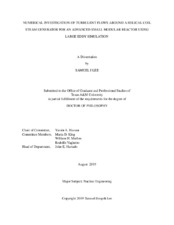| dc.description.abstract | The objective of this research is to investigate turbulent flow phenomena in shell-side fluid of a helical coil steam generator (HCSG) for an advanced small modular reactor (SMR) using large eddy simulation (LES). Unlike conventional studies based on the assumptions of two-dimensional cylinder tube bundle model with periodic boundary condition, a realistic three-dimensional steam generator geometry in a confined space is considered for a practical application. In this dissertation, two flow domains are considered: an annular sector channel with staggered semi-circular ribs and 1/45 sector of five-layered helical coil geometry. Both domains are parts of the full-scale model of a five-layered helical coil steam generator for a small modular reactor.
First, LES on the annular sector channel with semi-circular ribs is conducted to check the validity of the sub-grid scale (SGS) model. Additionally, unsteady Reynolds-averaged Navier-Stokes (URANS) simulation is performed to compare the results with the LES. The experimental results from particle image velocimetry (PIV) measurements are provided as validation data. In first-order statistics, both the LES and URANS simulation results have agreements with the PIV data in cases of streamwise direction velocity and z-vorticity; however, the spanwise direction velocity profiles show the URANS results underestimate the magnitude, while the LES has a good agreement with the PIV results. In second-order statistics, overall, the LES presents better results following the PIV data well in both trend and magnitude than the URANS simulation. In instantaneous fields, the LES resolves turbulent flows much better showing the small scale of motion inside the domain.
Second, numerical experiments on the 1/45 sector of five-layered helical coil geometry are performed to explore the turbulent flow behavior of realistic HCSG model using the LES. Also, LES for a five-layered coil bundle model without helix is conducted to produce comparison data. Various turbulent statistics are presented at multiple monitoring locations. The results from spectral analyses which include fast Fourier transform (FFT) and continuous wavelet transform (CWT) are addressed with the perspective of flow induced vibration (FIV). The three-dimensional effects of the helical geometry of coil bundle are discussed. | en |


